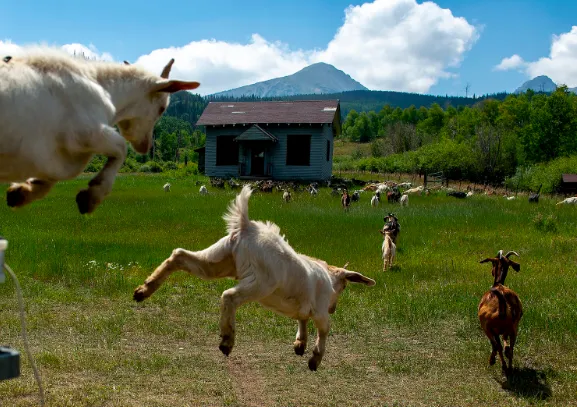Table of Contents
Yes, goats.
We do not need goats fertilizing the Oval, tripping about the traffic circles, acting as speed bumps for athletes on e-bikes, or squeezing into Stanford's innumerable construction sites. We do not need any more chaos in Main Quad than that already provided by tourists.
At the Dish, however, a little herd of goats would be quite valuable. It would, in fact, greatly benefit the ecosystem, improve the mental health of our community, and broaden the educational opportunities available to Stanford students. The tribe (or trip, both names for a group of goats) would be a low maintenance and unobtrusive way to bring joy to campus.
Goats would make the Dish environment healthier. In this, the rainiest of years, a drab brown still cloaks much of the open space; old, dry stalks are doing their best to choke out the new grass. In past years, the area became overgrown with mustard, I believe, which then shriveled to tall sticks in the summer. A hungry herd of goats would end this cycle of overgrowth, fertilize the plants, and aerate the ground.
Goat herds have been successfully introduced to other college campuses and California open space areas alike, where they act as automated lawn mowers and reduce fire risk. Our goats would give fresh green grass a shot against the whims of California's drought and flood cycles, the burrowing of the flourishing gopher population, and the off-trail wandering of Stanford's naughty undergraduates. Their (the goats', not the students') munching, stomping, and pooping would return the Dish's ecosystem to equilibrium. The herd would make the place healthy and beautiful.
Another reason Stanford needs a goat herd is that students desperately need a pick-me-up. Our mental health statistics are depressing. The Friday flowers, occasional llamas, chia seed pudding, and sunshine are a start, but more can be done. Why not allow some resident bovids to bring joy to this campus? The administration brings therapy puppies to campus during stressful periods of the quarter. We should make four-legged stress relievers a perennial part of campus life. Do not be anxious about anything, fellow students. Look at the goats of the Dish. They neither toil nor grind, but the Lord God and the Stanford name take care of them all. Goats are a walking picture of peace and joy, the perfect antidote to our extreme performance orientation.
A local goat herd would be another step towards Stanford becoming a leader in agricultural research and education. The herd would provide excellent research material for Earth Systems majors working to spend Stanford's money. A faculty member could design a new IntroSem titled "The Ethical Kid: The Future of California's Sustainable Animal Agriculture." If the herd becomes too numerous, a few goats can move to Stanford’s farm for lessons in milking and cheese making (to supplement the existing workshops in natural dyes and wild vinegar fermentation).
The implementation of the herd would not be difficult. Thanks to an enthusiastic park bureaucracy, we already have fences around the entire Dish. Why not put them to use for a few dozen goats? Throw down a few cattle guards, confirm a water source, drop off some goats, and we'll have a thriving ecosystem. The goat herd would be a better use of Stanford's dollars than most of the school's construction projects or the salary of a not-so-inclusive associate dean of inclusion. The cost of a little goat herd is nothing to Stanford's nebulous $8.2 billion budget, especially given this year's 7% increase in undergraduate tuition.
Stanford presumably does not keep goats due to logistics and liability issues (and perhaps a lack of creativity, which, I daresay, I have addressed). However, if the park rangers spent half the effort in keeping goats in the open space area as in keeping hikers out, and if Stanford devoted a snippet of its brain power to the issue, we could sort out the logistical challenges. For instance, the administration could exemplify non-threatening agricultural practices by using alpacas, guard dogs, or donkeys to deter coyote attacks.
As we introduce the tribe, I volunteer to be the first goat herder, with my vast knowledge of the occupation from reading Heidi. And as for liability issues... bring in the nannies and exclude the billies. The goats would give Stanford a beautiful landscape, a mental health boost, an academic resource, and even an opportunity for administrative virtue signaling.









